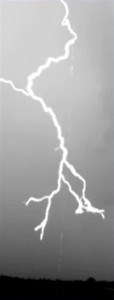14 March 2013
AGU Video: Lightning strike jumps the rails
Posted by mcadams
[youtube=http://www.youtube.com/watch?v=34NpyA2OuaE&feature=youtu.be&hd=1]
The famous “kite with key” experiment Ben Franklin conducted in 1752 is more than just a legend for lightning researchers around the world—it’s a procedure. Sure, the kite has been replaced by a rocket, and the string-with-key contraption by a spool of wire, but the intent is still the same—to better understand nature’s flashes of electricity. Recently, an unusual rocket-triggered lightning strike was caught on video by lightning researchers in Florida, and its curious course from cloud to ground is described in a new scientific paper.
To induce a lightning strike, researchers fire a rocket dragging a wire into an approaching electrical storm. If they are lucky, current will flow from the cloud, through the wire, to the ground, and vaporize the wire. If scientists witness a second lightning strike, it typically follows the path of the vaporized wire…but not always. On this particular dark and stormy afternoon in Florida, most of the wire exploded. But a second bolt, which burst from where the top of the wire had been, took a circuitous route, fracturing into multiple branches as it approached ground, said William Gamerota, a Ph.D. candidate at the University of Florida and lead author of the paper about this uncommon event.
Out of 410 previously triggered lightning strikes, this is the first off-course strike ever observed by researchers at the university’s International Center for Lightning Research and Testing, according to Gamerota. Lightning scientists in France and New Mexico have witnessed similar strikes, but the atmospheric and experimental differences between the sites make a direct comparison of the events difficult.
“It’s tough to tell why this happens, but it does happen,” Gamerota said. “Typically, the leader follows the path of the vaporized wire because it is apparently the path of least resistance, but this time, that was not the case.” Why this particular bolt broke the rules and meandered through virgin air instead of following the path of the vaporized wire is still a mystery. “I have a couple ideas,” Gamerota said, “but you’ll have to wait for my dissertation.”
He and his colleagues report on the anomalous lightning strike in an article accepted for publication in the Journal of Geophysical Research – Atmospheres, a publication of the American Geophysical Union (AGU).
–Sarah Charley is AGU’s current science writing intern










 GeoSpace is a blog on Earth and space science, managed by AGU’s Public Information staff. The blog features posts by AGU writers and guest contributors on all sorts of relevant science topics, but with a focus on new research and geo and space sciences-related stories that are currently in the news.
GeoSpace is a blog on Earth and space science, managed by AGU’s Public Information staff. The blog features posts by AGU writers and guest contributors on all sorts of relevant science topics, but with a focus on new research and geo and space sciences-related stories that are currently in the news.